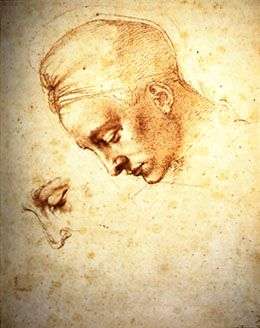 Michelangelo Buonarroti
Michelangelo Buonarroti
Studies for the Head of Leda
1530 circa
red pencil,
354 x 269 mm
inv. 7 F
The drawing is unanimously recognized as one of the finest and most important of Michelangelo’s entire graphic production. The bowed head, portrayed in profile, is reminiscent of the pose of the figure of Night in the New Sacristy, and displays a splendid sureness of touch made vibrant by the obvious fact that it was drawn from life. Wilde was the first to suggest that the model was Antonio Mini, one of the artist’s pupils, and this has been accepted by the majority of scholars. There is no need to point out how common it was for male models to be used for images of women in those days. What should be stressed, however, is the way that the sketch, at bottom left, of the detail of the nose and eye, with long and feminine lashes, softens the already gentle and thoughtful features of the profile. Scholars are also in agreement in referring the drawing to the Leda, the lost painting that is connected with some crucial moments in Michelangelo’s life and bound up with the complicated story of his relations with Alfonso d’Este, duke of Ferrara, and Pope Julius II. Excommunicated in the summer of 1510 for having chosen, as an adversary of Venice and ally of King Louis XII of France, the opposite side to that of the pope, Alfonso, following the unexpected defeat of the French, in Italy just two years later, decided to submit and went to Rome, where he obtained papal absolution. Three days afterward, on July 11, Julius II allowed him to climb onto the scaffolding of the Sistine Chapel, whose ceiling had by this time been almost completely frescoed by Michelangelo. The following long conversation between the artist and the duke, who was ecstatic with admiration, ended with a promise by Michelangelo to paint a picture for him. Seventeen years later Michelangelo, who had been given responsibility for the defenses of Florence, under siege by the papal forces, was in Ferrara, as Alfonso’s guest to study the city’s famous fortifications, and allowed himself to be persuaded to fulfill the duke’s long-standing desire. By around the middle of the following September, the “parlor picture” was finished. Yet it never reached Ferrara owing to the ignorance of the messenger sent by the duke to fetch it, who described the painting, to its author’s face, as “nothing much.” Michelangelo was enraged by this and, as we are told by Condivi, “shortly after the departure of the ducal messenger, gave the picture to one of his apprentices.” This apprentice was Antonio Mini who, in addition to the Leda seems to have received several drawings and the preparatory cartoon for the painting from Michelangelo. It has also been supposed, with same justification, that the painting was given to Mini not as a gift but to be sold. The fact remains that Mini was in France between 1531 and 1532, and that the Leda was undoubtedly in his possession. After his death (1533), there are conflicting records of further disputes over the painting. According to Vasari, it ended up in the collections of Francis I at Fontainebleau, as it was demonstrated by Janet Cox-Rearick, who speaks about the destruction of the panel, which was perhaps ordered by queen-mother Anne, towards the end of the seventeenth century. Michelangelo’s extraordinary invention, of which this drawing is a luminous presage, has come down to us through numerous copies and derivations in a wide variety of media.
